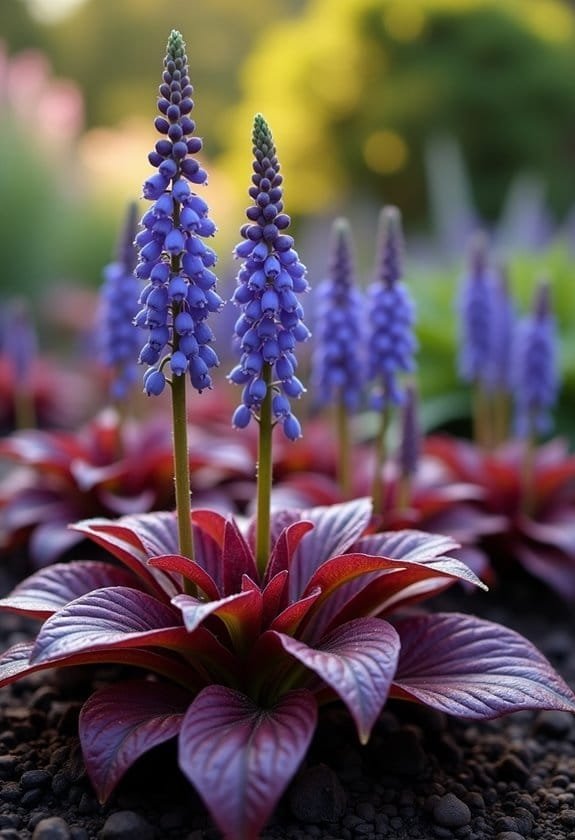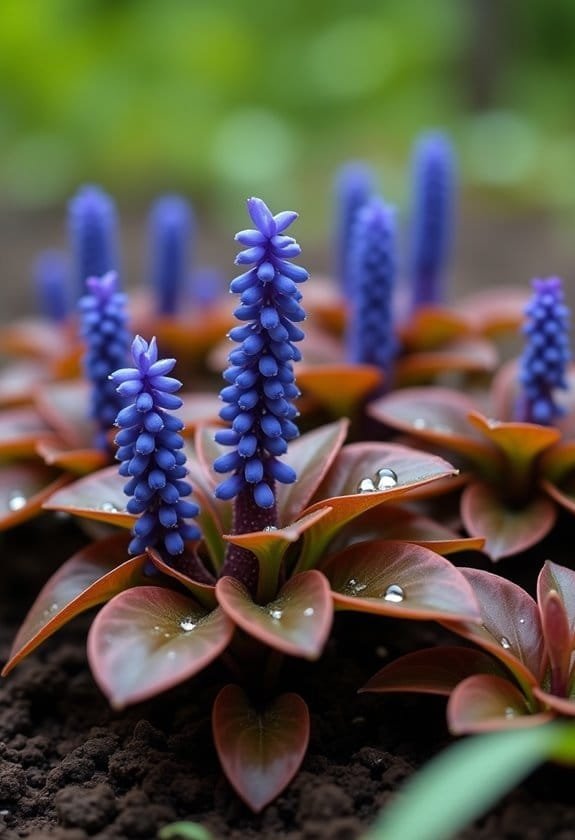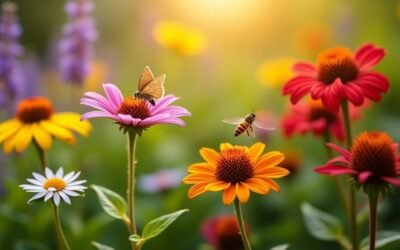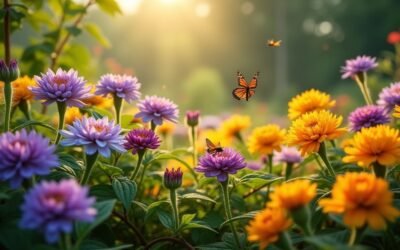Ajuga reptans (bugleweed) is a versatile perennial groundcover that creates dense, evergreen mats through its vigorous spreading habit via underground rhizomes. The plant thrives in USDA zones 3-10, reaching heights of 6-12 inches with glossy foliage and striking blue-violet flower spikes that extend 3-6 inches above the base during spring. It's particularly effective for erosion control and weed suppression, preferring well-drained soil and partial shade conditions. While its aggressive growth requires monitoring, bugleweed's low maintenance requirements, pollinator-friendly blooms, and year-round foliage interest make it an excellent choice for challenging landscape areas where many plants won't flourish.
Main Points
- Ajuga reptans is a hardy perennial ground cover that forms dense mats of glossy evergreen foliage and produces blue-violet flowers in spring.
- The plant spreads aggressively through underground rhizomes, making it excellent for weed suppression and erosion control in zones 3-10.
- Bugleweed thrives in well-drained soil with partial shade and requires minimal maintenance once established, needing only moderate watering.
- The plant attracts pollinators like bumblebees and butterflies during its flowering season, providing valuable early-season nectar sources.
- While low-maintenance, Ajuga reptans needs monitoring for crown rot in humid conditions and may require containment due to its invasive spreading habit.
Introduction

Ajuga reptans, commonly known as bugleweed or carpet bugle, stands as a resilient perennial ground cover that has garnered attention for its aggressive spreading capabilities.
Native to Europe, northern Africa, and southwestern Asia, this member of the Lamiaceae family has established itself as a versatile ornamental plant in gardens worldwide.
The evergreen to semi-evergreen species reaches heights of 6 to 12 inches, creating dense carpets of foliage punctuated by distinctive blue-violet flower spikes that emerge during the spring months.
Common Name
Known widely throughout the gardening world, bugleweed stands out as the primary common name for Ajuga reptans, though it's also called blue bugle, carpet weed, and bugleherb. This versatile ground cover has earned its various monikers through centuries of cultivation and practical applications across different regions.
One of its most intriguing alternative names, "carpenter's herb," reflects its historical significance in traditional medicine, where it was employed to stop bleeding from workplace injuries. The etymology of these common names often connects to the plant's distinctive characteristics, particularly its carpet-like growth pattern and striking blue-violet flower spikes that emerge in spring.
The scientific name Ajuga carries its own fascinating story, derived from Greek roots that emphasize the plant's non-toxic nature. While "a" means "not" and "ouga" translates to "sour," this nomenclature provides insight into the plant's safe interaction with humans and animals.
The species epithet "reptans" accurately describes its creeping growth habit, as the plant spreads through stolons to form dense, evergreen mats across various terrain types.
Scientific Name
The scientific classification of bugleweed places it firmly within the Lamiaceae family as Ajuga reptans, sharing kinship with mint, sage, and other aromatic herbs. This taxonomic placement reflects the plant's aromatic characteristics and structural similarities to its mint family relatives, though its fragrance is particularly more subtle than its cousins.
The species epithet "reptans" derives from the Latin word meaning "creeping" or "crawling," which perfectly describes the plant's growth habit through spreading runners. Native to Europe, northern Africa, and southwestern Asia, Ajuga reptans has established itself as a remarkably adaptable species across diverse geographical regions.
The plant demonstrates impressive resilience across USDA hardiness zones 3-10, thriving in various environmental conditions.
In its natural habitat, this ground-covering perennial reaches heights of 10-35 centimeters, producing striking blue-violet flowers arranged in dense racemes. These distinctive blooms emerge on erect spikes during mid to late spring, creating a captivating display that sets it apart from other members of the mint family, while maintaining the characteristic flower structure typical of Lamiaceae species.
Overview
Among the most versatile ground covers in ornamental gardening, bugleweed (Ajuga reptans) offers gardeners a robust solution for challenging landscape areas. This hardy perennial, native to Europe, northern Africa, and southwestern Asia, has established itself as a dependable option across USDA hardiness zones 3-10, adapting seamlessly to various growing conditions.
Ajuga reptans distinguishes itself through its dense mat-forming growth habit, featuring glossy evergreen foliage that creates a uniform carpet across the landscape. In mid to late spring, the plant produces striking spikes of blue-violet flowers that transform garden spaces while attracting essential pollinators, including bees and butterflies.
While it thrives in moist soil conditions, this adaptable ground cover demonstrates remarkable resilience in both full sun and partial shade environments. Gardeners should note that while its vigorous spreading habit through runners and seeds makes it excellent for weed suppression, careful consideration is needed when introducing it to new areas.
The species has spawned several cultivars, including the distinctive 'Burgundy Glow' and 'Black Scallop,' which offer varying foliage colors and textures for diverse landscape applications.
Key Features
Ajuga reptans exhibits a distinctive low-growing profile, reaching heights of 4 to 12 inches while spreading indefinitely through its network of vigorous runners.
The plant's glossy, evergreen foliage displays remarkable variation, from deep green to purple hues, with certain cultivars featuring striking variegated patterns that add year-round visual interest.
During mid to late spring, the plant produces dense racemes of blue-violet flowers that transform the groundcover into a pollinator paradise, attracting bees and butterflies to the garden.
Growth Size
As a compact ground cover, Ajuga reptans reaches heights between 6 to 12 inches (15 to 30 cm) while spreading indefinitely through underground rhizomes. This herbaceous perennial forms a dense mat of broad, oval-shaped foliage that effectively blankets the ground, making it an excellent choice for controlling soil erosion and suppressing unwanted weeds.
The plant's growth size is particularly notable when considering its flower spikes, which emerge in mid to late spring and extend 3 to 6 inches (7.5 to 15 cm) above the main foliage. Individual plants can achieve a width of approximately 12 inches (30 cm), though the species spreads quickly to colonize much larger areas when conditions are favorable.
The plant's vigorous spreading habit creates a tapestry-like ground cover that can transform bare spaces into lush carpets of vegetation.
While its spreading nature makes it an efficient ground cover, gardeners should carefully consider this characteristic when planning their landscapes, as Ajuga reptans's aggressive growth pattern may require regular maintenance to keep it within desired boundaries.
The plant's mat-forming tendency proves particularly useful in shaded areas where other plants struggle to establish.
Appearance
Three distinctive features define the appearance of bugleweed: its evergreen to semi-evergreen oval leaves, dense flowering spikes, and spreading rosettes of foliage. As a member of the Lamiaceae family, Ajuga reptans displays characteristic square stems adorned with fine hairs along two sides, contributing to its unique structural profile.
The plant's foliage exhibits remarkable versatility in coloration, ranging from glossy medium green to rich dark maroon, depending on the cultivar selection. During mid to late spring, the ground cover erupts in a stunning display of blue-violet flowers, arranged in concentrated racemes that rise purposefully above the leafy base. These vertical flowering spikes create a striking contrast against the horizontal spread of the plant's foliage mat.
Perhaps most notable is the plant's ability to form tight, weed-suppressing rosettes that create an effective living carpet across the landscape. The leaves maintain their presence throughout most of the year, while the plant's distinctive fruit structure, a four-chambered schizocarp, develops following the flowering period, adding further botanical interest to this versatile ground cover.
Flowering Season
The splendor of spring reaches its peak when Ajuga reptans bursts into bloom, typically from mid to late spring. During this vibrant period, the plant produces dense racemes of showy blue-violet flowers that create a mesmerizing carpet of color in garden settings and natural landscapes.
These flowering plants showcase their beauty through vertical spikes that rise 3-6 inches above the foliage, presenting clusters of small but intricate blooms. Each flower displays distinctive dark veins along its lower lip, enhancing the overall ornamental appeal of the plant. The flowering season extends for several weeks, ensuring a sustained display of natural beauty throughout the spring months.
Beyond their aesthetic value, these blue flowers serve an essential ecological function by attracting pollinators to the garden. Bees and butterflies are particularly drawn to the nectar-rich blooms, making Ajuga reptans an excellent choice for biodiversity-focused landscaping.
The extended blooming period provides a reliable food source for these beneficial insects, contributing to the health and robustness of the surrounding ecosystem.
Growing Requirements

Ajuga reptans flourishes in well-drained soils with medium moisture content, requiring consistent watering of 1-2 inches weekly during its establishment phase.
The plant demonstrates remarkable adaptability to various light conditions, from full sun to partial shade, though it performs best in dappled sunlight where it can balance photosynthesis with moisture retention.
While temperature-tolerant, this ground cover thrives when planted 12 inches apart in organic-rich soil, rarely needing fertilization beyond an optional spring boost with balanced nutrients.
Light
Growing successfully in diverse light conditions, bugleweed demonstrates remarkable adaptability from full sun to partial shade. This versatile ground cover thrives particularly well in dappled sunlight, where its foliage exhibits peak coloration and maintains robust health throughout the growing season.
While the plant tolerates full sun exposure, maintaining consistently moist soil becomes essential in these brighter locations to prevent stress and guarantee vigorous growth.
In shaded environments, Ajuga reptans often displays its most impressive spreading capabilities, capitalizing on cooler soil temperatures and reduced competition from other plants. The shade-loving nature of this species makes it an excellent choice for woodland gardens and areas beneath tree canopies where many other plants struggle to establish.
However, gardeners should be mindful that deep shade can result in leggy, stretched growth patterns and diminished flowering performance. The ideal balance typically lies in providing morning sun with afternoon shade, or filtered light throughout the day, which promotes both healthy foliage development and abundant blooming periods while maintaining the plant's compact growth habit.
Soil
Successful cultivation of Ajuga reptans begins with proper soil conditions, requiring well-drained, medium moisture soil enriched with organic matter. This versatile ground cover demonstrates remarkable adaptability to various soil compositions, from sandy substrates to heavier clay-based mediums, making it an excellent choice for diverse garden environments.
While Ajuga reptans can tolerate different soil types, it performs best in slightly acidic to neutral pH conditions that mirror its natural woodland habitat. Regular incorporation of organic matter, particularly well-aged compost, enhances the soil structure and provides essential nutrients for robust growth and spreading.
Gardeners should maintain consistent soil moisture levels, especially during the plant's establishment phase, while being cautious not to create waterlogged conditions that could lead to destructive crown rot.
The key to thriving Ajuga reptans lies in achieving the delicate balance between moisture retention and adequate drainage. Amending the planting area with organic materials creates an ideal growing medium that supports both the plant's moisture requirements and its need for proper root aeration, ultimately fostering vigorous growth and healthy foliage development.
Water
Moisture management plays an essential role in cultivating healthy Ajuga reptans, with plants requiring 1-2 inches of water weekly during their initial establishment period.
Like a well-calibrated irrigation system, this consistent watering schedule helps develop strong root systems and promotes vigorous growth in newly planted specimens.
Once established, these hardy ground covers demonstrate remarkable drought resistance, though they still benefit from approximately one inch of weekly watering during extended dry spells.
While Ajuga reptans appreciates moist soil conditions, gardeners must carefully balance water requirements to prevent potential problems.
Overwatering, particularly in dense or poorly-draining soils, can trigger devastating root rot that compromises plant health.
Success in growing Ajuga reptans hinges on regular monitoring of soil moisture levels, especially in regions with hot, humid climates where crown rot poses a significant threat.
Gardeners should assess soil dampness by inserting their finger about an inch into the substrate, adjusting irrigation accordingly.
This careful attention to water management guarantees plants maintain peak health while avoiding the perils of excessive moisture.
Temperature
Beyond water requirements, temperature considerations shape the versatility of Ajuga reptans as a reliable ground cover. This remarkable plant demonstrates exceptional adaptability across USDA hardiness zones 3 through 10, making it suitable for diverse climatic conditions throughout most regions. Its resilient nature allows it to withstand significant temperature fluctuations while maintaining healthy growth patterns.
While Ajuga reptans exhibits a natural preference for cooler environments, it has developed impressive mechanisms to thrive in warmer climates when provided with adequate moisture and shade. The plant's drought-resistant characteristics become particularly valuable in regions experiencing higher temperatures, as established specimens can survive extended periods with minimal watering.
However, in hot and humid conditions, proper air circulation becomes essential for preventing common issues like mildew formation, which could otherwise compromise the plant's health. Gardeners in warmer zones should consider strategic placement that balances sun exposure with adequate airflow, ensuring ideal growing conditions.
This temperature adaptability, combined with its other hardy characteristics, positions Ajuga reptans as an excellent choice for various landscape applications across different climate zones.
Pollinator Criteria
Ajuga reptans serves as a crucial nectar source for numerous pollinators, with its striking blue-violet flower spikes attracting bumblebees, butterflies, and even hummingbirds during the critical spring feeding period.
The plant's flowering coincides with the emergence of early-season pollinators, making it an especially valuable food source when many other plants remain dormant.
These pollinator interactions prove particularly beneficial in shaded garden areas, where Ajuga's ability to thrive creates essential feeding stations for diverse insect species that might otherwise struggle to find sufficient nutrition in woodland settings.
Attracted Pollinators
Flourishing in spring gardens, the vibrant blue-violet flowers of bugleweed serve as essential nectar stations for various pollinators. The plant's strategic blooming period aligns perfectly with the emergence of early-season pollinators, providing critical sustenance when many other nectar sources remain dormant.
The flowering spikes, reaching heights of 3-6 inches, create an accessible feeding platform for diverse pollinator species. Bumblebees, particularly drawn to the plant's rich nectar reserves, navigate the dense flower clusters with remarkable efficiency, while butterflies gracefully maneuver between the upright blooms.
The flowers' sophisticated design includes dark veining patterns on their lower lips, acting as natural runway lights that guide visitors directly to their sweet reward.
Bugleweed's adaptability to shaded environments makes it especially valuable for supporting pollinator populations in areas where sun-loving nectar plants struggle to thrive. This versatility enables the creation of pollinator-friendly corridors throughout various garden zones, effectively extending the reach of beneficial insects and contributing to the overall health of local ecosystems.
Pollination Method
The pollination process of Ajuga reptans showcases a remarkable interplay between flower structure and insect behavior. Its densely packed blue flowers feature specialized tubular shapes with distinctive dark veins that serve as natural landing strips, efficiently guiding pollinators to their nectar reward.
During the plant's peak flowering period in mid to late spring, the intricate pollination mechanism relies heavily on insect visitors, particularly bumblebees and butterflies. These pollinators are drawn to the plant's abundant nectar source, and as they move between flowers, they inadvertently transfer pollen from one bloom to another.
The timing of Ajuga's flowering perfectly synchronizes with the emergence of these essential pollinator species, creating a mutually beneficial relationship that guarantees successful reproduction.
The plant's adaptability to various light conditions enhances its role in supporting pollinator populations across different garden environments.
Scientific studies have demonstrated a direct correlation between increased pollinator visits and enhanced seed production, highlighting the effectiveness of Ajuga's pollination strategy in both sunny locations and shaded areas.
Care & Maintenance

Successful cultivation of Ajuga reptans begins with proper spacing of one foot between plants in well-drained soil, ensuring adequate airflow to prevent disease while establishing a weekly watering schedule of 1-2 inches.
The plant's maintenance requires regular deadheading of spent flower spikes and biannual pruning of runners to manage its vigorous spreading habit, which helps maintain the desired garden footprint.
Gardeners should monitor leaf health closely, watching for yellowing foliage that signals potential overcrowding or light deficiency, making adjustments to spacing or exposure as needed to promote ideal growth conditions.
Planting Tips
Proper planting and maintenance of Ajuga reptans starts with selecting well-drained soil enriched with organic matter. This versatile ground cover adapts well to both sandy and clay-based environments, making it a flexible choice for various garden conditions.
When incorporating organic material, work it thoroughly into the existing soil to create an ideal growing medium that promotes healthy root development.
Spacing plays an essential role in establishing a thriving Ajuga reptans colony. Plants should be positioned 12-18 inches apart, allowing sufficient room for their natural spreading tendency while maintaining adequate air circulation.
During the initial establishment period, consistent moisture is necessary for robust growth, requiring approximately 1-2 inches of water weekly. While the plant doesn't demand frequent fertilization, applying a balanced, slow-release fertilizer in early spring can give it an extra boost when needed.
To prevent overcrowding and maintain the plant's health, it's important to implement a regular maintenance schedule that includes thinning dense patches every 2-3 years. This practice, combined with the removal of spent flower spikes, guarantees continuous blooming and prevents the ground cover from becoming too aggressive.
Ongoing Care
Following initial planting, Ajuga reptans requires specific ongoing care practices to maintain its vibrant appearance and controlled growth. In full shade or partial sun locations, these ground-covering plants need consistent moisture, demanding approximately one inch of water weekly to sustain their lush foliage.
While Ajuga can spread rapidly through runners, maintaining appropriate spacing of 12-18 inches between plants helps prevent overcrowding and reduces the risk of crown rot in dense plantings. Gardeners should trim back these runners twice annually to keep the plant's spreading tendency in check and preserve the intended garden design.
Regular maintenance includes removing spent flower stalks through deadheading, which not only improves aesthetic appeal but also promotes additional blooming throughout the growing season.
Though Ajuga reptans typically thrives without extensive fertilization, applying a balanced, slow-release fertilizer in early spring can give the plants an extra boost when needed.
This adaptive ground cover's ongoing care routine focuses primarily on moisture management and growth control, making it a relatively low-maintenance option for garden spaces that benefit from its carpet-like coverage.
Suggested Companions
Thoughtfully selected companion plants enhance Ajuga reptans' natural beauty while maximizing garden space. The plant's low-growing, shade-loving nature makes it particularly compatible with taller specimens that create layered garden compositions.
Ferns prove to be exceptional companions, with varieties like Lady Fern and Japanese Painted Fern offering striking textural contrasts against ajuga's dense foliage.
Hostas, another shade-loving favorite, complement ajuga's ground cover characteristics while introducing diverse leaf sizes and colors that create visual interest throughout the growing season.
Spring-flowering bulbs, particularly daffodils and tulips, can be strategically placed among ajuga plantings to provide successive waves of blooms as seasons progress.
For year-round appeal, pairing ajuga with heucheras creates stunning color combinations, as their varied foliage hues range from deep purples to vibrant chartreuse.
Candelabra Primroses and Lamium make excellent complementary ground cover companions, working together to form a cohesive carpet of foliage and flowers that suppresses weeds while maintaining visual interest through different growth cycles.
What Are the Differences in Growth Habits Between Buxus Sempervirens and Ajuga Reptans?
Buxus sempervirens plant exhibits upright growth, forming dense, compact shrubs ideal for formal hedging, while Ajuga reptans spreads low to the ground, creating a carpet of foliage and flowers. The former thrives in structured landscapes, whereas the latter excels in ground cover for areas requiring texture and resilient growth.
Common Issues
Ajuga reptans faces several significant challenges, with crown rot emerging as a primary concern in humid conditions and poorly draining soils that can lead to rapid plant decline.
While some cultivars demonstrate impressive resistance to diseases like phytophthora and fusarium wilt, gardeners must remain vigilant for early warning signs such as yellowing leaves and stem deterioration.
Regular monitoring combined with proper cultural practices, including adequate spacing for air circulation and strategic placement in well-draining soil, offers the most effective defense against these common issues.
Pests/Diseases
The most significant health challenges for Ajuga reptans stem from moisture-related issues, with crown rot being particularly problematic in humid conditions and poorly-drained soils. When affected by crown rot, plants typically show signs of decline at the base, eventually leading to widespread deterioration of the entire specimen.
Leaf spot diseases represent another common concern, manifesting as dark, water-soaked lesions on foliage that can spread rapidly through dense plantings. These fungal infections often flourish in overcrowded gardens where air circulation is limited, creating an ideal environment for pathogen development.
While Ajuga generally demonstrates strong pest resistance, occasional aphid infestations can emerge, causing distorted growth patterns and potentially transmitting viral diseases throughout the plant colony.
Fortunately, several modern cultivars offer enhanced resistance to diseases like phytophthora, making them excellent choices for challenging garden conditions. Fusarium wilt poses an additional threat, particularly to stressed plants, causing characteristic yellowing and wilting of foliage as the soil-borne pathogen disrupts the plant's vascular system.
Solutions
Several practical solutions exist for common Ajuga reptans issues, with proper drainage being the cornerstone of healthy growth. Gardeners can prevent crown rot by ensuring well-draining soil conditions and implementing a careful watering schedule that avoids oversaturation, particularly in humid environments.
For maintaining ideal plant health, regular monitoring of leaf color serves as a diagnostic tool. When yellowing occurs, adjusting sunlight exposure or addressing drainage problems can quickly restore the plant's liveliness.
To manage this vigorous ground cover's spreading tendency, implementing a biannual pruning schedule for runners helps maintain aesthetic boundaries while preventing overcrowding of neighboring plants.
In cases where pests and diseases threaten the plant's well-being, improving air circulation becomes essential. Removing affected foliage promptly and maintaining appropriate spacing between plants can greatly reduce the risk of leaf spot and fusarium wilt.
When the ground cover becomes too dense, dividing and transplanting sections not only manages spread but also rejuvenates the plant, acting like a reset button for troubled areas while providing opportunities to expand coverage in desired locations.
Summary

Ground-hugging and resilient, bugleweed stands as a popular perennial ground cover reaching heights between 6 to 12 inches with glossy evergreen foliage. This versatile Ajuga reptans has earned its place in gardens across USDA zones 3 through 10, adapting seamlessly to various light conditions from full sun to deep shade.
During mid to late spring, the plant transforms landscapes with its striking display of blue-violet flowers, creating a vibrant carpet that attracts essential pollinators like bees and butterflies.
While its low-maintenance nature and deer resistance make it an attractive option for gardeners, its aggressive spreading tendency through underground rhizomes requires careful consideration.
The plant's invasive characteristics can pose challenges in certain regions, where it may outcompete native species and impact local biodiversity.
Despite these concerns, bugleweed's adaptability and resilience continue to make it a sought-after ground cover solution, particularly in challenging landscape areas.
Its ability to form dense, evergreen mats provides year-round interest while requiring minimal care, making it an enduring choice for both novice and experienced gardeners.


